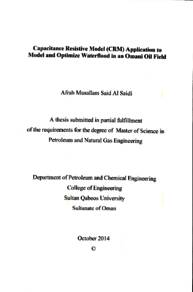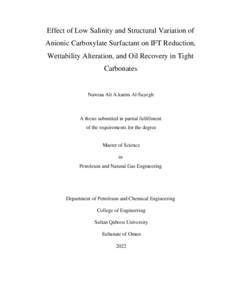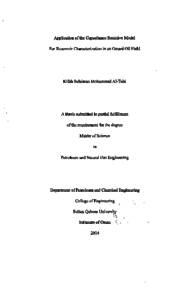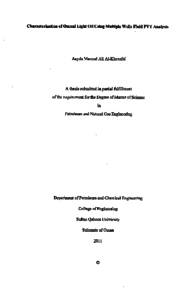وثيقة
Capacitance resistive model (CRM) application to model and optimze waterflood in an Omani oil field
الناشر
Sultan Qaboos University
ميلادي
2014
اللغة
الأنجليزية
الموضوع
الملخص الإنجليزي
In petroleum engineering, there are wide and crucial usages of the reservoir simulation to develop, manage and monitor reservoirs. However, the traditional simulation methods are time consuming to prepare and model data. In addition, data uncertainty is another problem of old methods since they require many data to set up and run the simulator. Capacitance Resistive Model (CRM) offers rapid reservoir simulation with lower and more reliable data to manage and optimize production from hydrocarbon reservoirs.
Capacitance Resistive Model is a quantitative technique based on material balance that uses only injection/production rates and well coordinates to identify and quantify interwell connectivity in waterflooding. It deals with the reservoir as a system that has injection rates as the input and production rates as the output. CRM parameters are identified by estimating fractions of injected fluid and the time taken to reach a producer.
After calibrating the historical data with CRM, the model is used to predict the future oil production. Then, the future production is maximized and optimized by reallocating the water injection rates. This tool is preferred due to its simplicity, the short computation time and the usage of available field data such as injection/production data of reservoir.
This research project aims to apply CRM to simulate waterflooding process in an Omani oil field using only injection production history data. Interwell connectivities are determined by fitting CRM over the historical data of the field. The effectiveness of the fitted model is examined through the historical events and then used to forecast and optimize the future production by reallocating the injection profile to the injectors.
The results of the study show good match for some producers and bad match for others with average error around 8.7%. In addition, ranking approaches for a reservoir with six injectors indicate that I1 and 16 are good injectors and by injecting more water to them in the future, these wells can lead to higher production. The optimized scenario of the given field (59% of available water is for good injectors and 41% for normal injectors) leads to 29.90% increase in future oil production more than using the base case.
المجموعة
URL المصدر
الملخص العربي
في هندسة البترول هناك استخدامات واسعة ومهمة لمحاكاة المكامن النفطية لتطوير وإدارة ومراقبة الخزان، ومع ذلك فإن طرق المحاكاة التقليدية لإعداد البيانات مستهلكة للوقت، إضافة إلى ذلك فإن عدم الدقة في البيانات هو مشكلة أخرى للطرق القديمة لأنها تتطلب العديد من البيانات الإنشاء وتشغيل برنامج المحاكاة، نموذج السعة المقاومة يقدم محاكاة المكامن بسرعة مع بيانات أقل وموثوقية أكبر لإدارة وتحسين الإنتاج من المكامن الهيدروكربونية.
نموذج السعة المقاومة هو أسلوب کمي يعتمد على توازن المواد التي تستخدم فقط معدلات الحقن الإنتاج فقط، وإحداثيات آبار النفط لتحديد وقياس التوصيلية بين الآبار، إنها تتعامل مع الخزان كنظام يمتلك معدلات حقن تمثل الإدخال ومعدلات الإنتاج تمثل الإخراج، عوامل نموذج السعة المقاومة تعرف عن طريق تقدير جزء السائل المحقون والوقت الذي يستغرقه للوصول إلى المنتج بعد معايرة البيانات التاريخية بنموذج السعة المقاومة، فإن النموذج يستخدم للتنبؤ بإنتاج النفط في المستقبل، ثم تتم زيادة الإنتاج في المستقبل عن طريق إعادة توزيع معدلات حقن الماء، وهذه الأداة مفضلة نظرا لبساطتها، وقصر وقت الحساب، واستخدام البيانات الميدانية المتاحة مثل بيانات حقن / إنتاج الخزان. ويهدف هذا المشروع البحثي إلى تطبيق نموذج السعة المقاومة لمحاكاة عملية فيضانات الماء في حقل من حقول النفط العمانية باستخدام بيانات التاريخية للحقن الإنتاج فقط، ويتم تحديد التوصيلية بين الآبار عن طريق مطابقة نموذج السعة المقاومة مع البيانات التاريخية للحقل، ويتم فحص فعالية النموذج من خلال الأحداث التاريخية ومن ثم استخدامها للتنبؤ وتحسين الإنتاج في المستقبل عن طريق إعادة توزيع حقن الماء.
نتائج الدراسة تظهر مطابقة جيدة بالنسبة لبعض آبار الإنتاج ومطابقة سيئة للأبار الأخرى مع متوسط خطأ تقريبا % 8.7 ، بالإضافة إلى ذلك، طريقة ترتيب الآبار لخزان به ستة آبار حقن تشير إلى أن 11 و 16 آبار حقن جيدة، وعن طريق حقن المزيد من المياه لهم في المستقبل يمكن لهذه الآبار أن تؤدي إلى زيادة الإنتاج، السيناريو الأمثل للحقل المعطى (59٪ من المياه الآبار الحقن الجيدة و 41٪ من المياه الآبار الحقن العادية) يؤدي إلى زيادة 29.90٪في إنتاج النفط في المستقبل أكثر من استخدام الوضع الحالي.
نموذج السعة المقاومة هو أسلوب کمي يعتمد على توازن المواد التي تستخدم فقط معدلات الحقن الإنتاج فقط، وإحداثيات آبار النفط لتحديد وقياس التوصيلية بين الآبار، إنها تتعامل مع الخزان كنظام يمتلك معدلات حقن تمثل الإدخال ومعدلات الإنتاج تمثل الإخراج، عوامل نموذج السعة المقاومة تعرف عن طريق تقدير جزء السائل المحقون والوقت الذي يستغرقه للوصول إلى المنتج بعد معايرة البيانات التاريخية بنموذج السعة المقاومة، فإن النموذج يستخدم للتنبؤ بإنتاج النفط في المستقبل، ثم تتم زيادة الإنتاج في المستقبل عن طريق إعادة توزيع معدلات حقن الماء، وهذه الأداة مفضلة نظرا لبساطتها، وقصر وقت الحساب، واستخدام البيانات الميدانية المتاحة مثل بيانات حقن / إنتاج الخزان. ويهدف هذا المشروع البحثي إلى تطبيق نموذج السعة المقاومة لمحاكاة عملية فيضانات الماء في حقل من حقول النفط العمانية باستخدام بيانات التاريخية للحقن الإنتاج فقط، ويتم تحديد التوصيلية بين الآبار عن طريق مطابقة نموذج السعة المقاومة مع البيانات التاريخية للحقل، ويتم فحص فعالية النموذج من خلال الأحداث التاريخية ومن ثم استخدامها للتنبؤ وتحسين الإنتاج في المستقبل عن طريق إعادة توزيع حقن الماء.
نتائج الدراسة تظهر مطابقة جيدة بالنسبة لبعض آبار الإنتاج ومطابقة سيئة للأبار الأخرى مع متوسط خطأ تقريبا % 8.7 ، بالإضافة إلى ذلك، طريقة ترتيب الآبار لخزان به ستة آبار حقن تشير إلى أن 11 و 16 آبار حقن جيدة، وعن طريق حقن المزيد من المياه لهم في المستقبل يمكن لهذه الآبار أن تؤدي إلى زيادة الإنتاج، السيناريو الأمثل للحقل المعطى (59٪ من المياه الآبار الحقن الجيدة و 41٪ من المياه الآبار الحقن العادية) يؤدي إلى زيادة 29.90٪في إنتاج النفط في المستقبل أكثر من استخدام الوضع الحالي.
قالب العنصر
الرسائل والأطروحات الجامعية






